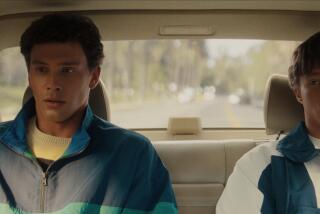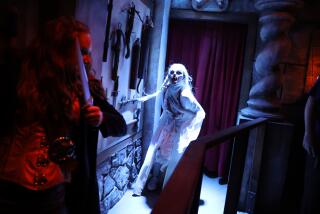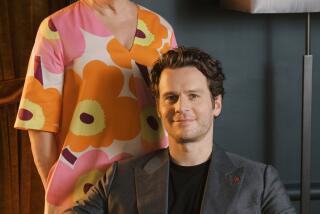MOVIE REVIEWS : What Becomes a Monster Most? : Branagh, De Niro Take on a Classic: ‘Mary Shelley’s Frankenstein’
They’re calling it “Mary Shelley’s Frankenstein,” but, with apologies to the former rock group, “Frankie Goes to Hollywood” is more like it.
That was the idea, of course. Why not join the verve and artistic intelligence director Kenneth Branagh brought to Shakespeare (“Henry V,” “Much Ado About Nothing”) to this most durable of fright tales, continuously in print since 1818 and the subject of several dozen films, ranging in seriousness from the 1931 James Whale/ Boris Karloff classic to the iffier “I Was a Teenage Frankenstein,” “Frankenhooker” and “Frankenstein Created Woman”?
But like the creature itself, this notion rapidly got out of hand. Seduced by a $40-million budget and the chance to do things like use a million gallons of water to create a storm and build the biggest exterior set ever constructed at a British studio, Branagh, who also stars as the doctor who dared create life in the lab, soon lost perspective.
In what feels a bit like slumming, the director, abetted by screenwriters Steph Lady and Frank Darabont (“The Shawshank Redemption”), decided that mass audiences didn’t need wit or discernment but wanted things broad and slapdash. Presumably concurring in this analysis were the same trio of producers who turned “Bram Stoker’s Dracula” into a similar mess.
As a result, “Mary Shelley’s Frankenstein,” like the creature itself, is awkwardly stitched together from a number of thematic elements. There is a bit of passionate romance for the doctor and his adopted sister Elizabeth (Helena Bonham Carter), a quiet country interlude for the creature (Robert De Niro) he builds and abandons, but mostly there is the kind of frantic frenzy that creates headaches rather than arouses emotions.
Full-bore hysteria is the ruling passion here, infecting everything from Patrick Doyle’s thumping score to eye-widening performances from most of the cast. Hardly a sequence goes by without someone, usually the director himself, operatically bellowing “Noooooo” like a fiend in torment.
While its traditional for the creature to come off best in these films, De Niro’s character earns our special affection by not screaming at maximum volume like everyone else. Looking like “Raging Bull’s” Jake La Motta after losing a close decision to a Cuisinart, the creature is not as fearfully articulate as he was in Shelley’s original, where lines like “I am well satisfied that abhorrence and opprobrium should load my memory” fell from his lips.
Still, well-played by De Niro under supple foam latex makeup devised by Daniel Parker, the creature is the most convincing and sympathetic thing in the movie, a misunderstood nice guy who would prefer philosophical discussions to physical violence. Karloff’s laurels, as well as those of makeup pioneer Jack Pierce, are not in danger, but at least the creature isn’t an embarrassment, which in this film is an accomplishment.
Before the creature gets to put in an appearance, however, “Mary Shelley’s Frankenstein,” which is fitfully faithful to the original, follows the book by sketching in a complex back story for the doctor. He is kind enough to relate it himself to Captain Robert Walton (an uncomfortable-looking Aidan Quinn), an explorer he chances to meet in 1794 while chasing the creature in the vicinity of the Arctic circle.
Back we go to sunny Geneva, where young Victor grows up under the eye of his doctor-father (Ian Holm), an earnest young man with a passion for books and a belief in the power of science that the unexpected death of his mother only intensifies. “No one need ever die,” is one of his favorite phrases, with “I will stop this, I promise” in second place.
At medical school in Ingolstadt, Victor makes a solid friend in fellow student Henry Clerval (Tom Hulce, in knee-breeches perhaps left over from “Amadeus”) but falls under the sinister influence of Professor Waldman (an uncharacteristically somber John Cleese), also fascinated with the possibilities of artificially creating life.
Tearing around his spacious attic lab in an enormous robe, Victor is successful in his experiments, but oh, what a price must be paid. Like more conventional children, the creature is far from grateful at being brought into the world, and between the bloody troubles it causes and those visited upon it, its prime mover--Victor--would be forgiven if he wished he’d stayed home and gone into the cheese business.
Even if the vivid Whale/Karloff version had never been made, this treatment of the Shelley novel would be a loud and tacky disappointment. It lacks the gravity, the dignity, even the humor of its illustrious predecessor, and director Branagh, with his wearisome fascination with swooping, disorienting camera movements (Roger Pratt is the cinematographer) acts like this is his first feature, not his fifth. “God forgive me,” his Victor says at one point, and though the deity may oblige, others may find it more difficult.
* MPAA rating: R, horrific images. Times guidelines: It includes several bloody scenes and one particularly gruesome one.
‘Mary Shelley’s Frankenstein’
Robert De Niro: Creature Kenneth Branagh: Victor Tom Hulce: Henry Helena Bonham Carter: Elizabeth Aidan Quinn: Walton Ian Holm: Victor’s Father Richard Briers: Grandfather John Cleese: Professor Waldman An American Zoetrope production, in association with Japan Satellite Broadcasting, Inc. and The Indieprod Company, released by Tristar Pictures. Director Kenneth Branagh. Producers Francis Ford Coppola, James V. Hart, John Veitch. Executive producer Fred Fuchs. Screenplay Steph Lady and Frank Darabont, from the novel by Mary Shelley. Cinematographer Roger Pratt. Editor Andrew Marcus. Costumes James Acheson. Music Patrick Doyle. Production design Tim Harvey. Art directors John Fenner, Desmond Crowe. Running time: 2 hours, 8 minutes.
* In general release throughout Southern California.
More to Read
Only good movies
Get the Indie Focus newsletter, Mark Olsen's weekly guide to the world of cinema.
You may occasionally receive promotional content from the Los Angeles Times.











